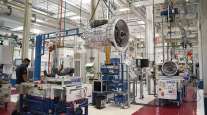Factory Output Cools After Biggest Gain Since February

Factory production cooled in December as capital spending and vehicle assemblies slowed, indicating U.S. manufacturers were adjusting to weaker overseas markets.
The 0.3% increase in output followed a 1.3% November gain that was the strongest since February, data from the Federal Reserve showed Jan. 16. Total industrial production fell 0.1% as utility use slumped.
Manufacturing growth is slowing to a more sustainable pace as factories take in fewer orders for business equipment and global economies struggle for traction. At the same time, production probably will be underpinned by steady U.S. demand as employment and cheap fuel help power consumer spending.
“As the rest of the world slows and serves as a drag, our own domestic demand should be picking up,” Raymond Stone, managing director at Stone & McCarthy Research Associates, said before the report. “It’s not jump-for-joy good, but I think we’re moving in the right direction.”
Manufacturing output, which accounts for about 12% of the economy, was projected to rise 0.2% last month after a previously reported 1.1% surge, according to the Bloomberg News survey median. Total industrial production was forecast to fall 0.1%.
Capacity utilization, which measures the amount of a plant that is in use, eased to 79.7% in December from 80% the prior month, which was the highest since March 2008.
Utility output plunged 7.3%, the most since January 2006, after a 4.2% gain the previous month, the Fed said. Americans adjusted their thermostats as temperatures climbed. Last month was the second-warmest December in records dating to 1939, according to the National Climatic Data Center.
Mining production, including oil drilling, increased 2.2% in December, the most since March 2011, after a 0.3% drop. Oil- and gas-well drilling decreased 1.9%, the biggest decline since August 2012, after a 0.5% decrease a month earlier.
Factory output of consumer goods fell 1.1% in December after rising 2.5%. Business equipment production increased 0.1% after a 1.4% jump. Machinery production and wood products output also dropped.
The output of motor vehicles and parts decreased 0.9% after rising 5.5%. Excluding autos and parts, factory production increased 0.4% after rising 1 % the prior month.
Industry data show demand for vehicles is holding up. Sales of cars and light trucks held near a more than eight-year high in December, reaching a 16.8 million annualized rate in December, according to figures from Ward’s Automotive Group.
The report on output corroborates other figures. The Institute for Supply Management’s factory index fell in December to a six-month low. Even with the larger-than-projected decline, the average for all of 2014 was the highest in nine years, the Tempe, Arizona-based group’s data showed Dec. 31.
Factories face the challenge of weaker overseas demand. On Jan. 13, the World Bank reduced its forecast for 2015 global-economic growth to 3% from 3.4%. The Washington-based lender said the global economy resembles a train pulled by a single engine, the United States, with other regions dragging behind. It cut projections for the euro area and Japan.
Falling energy prices have compelled some American manufacturers to cut costs. U.S. Steel Corp., the nation’s second-largest producer of the metal, said Jan. 5 that it planned to idle two pipe plants and lay off more than 750 workers. The Pittsburgh-based company cited “softening market conditions influenced by oil prices and trade” for its decision, spokeswoman Courtney Boone said in a Jan. 6 phone interview.




